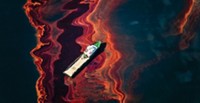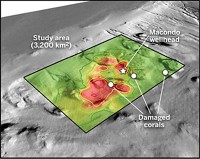Advertisement
Grab your lab coat. Let's get started
Welcome!
Welcome!
Create an account below to get 6 C&EN articles per month, receive newsletters and more - all free.
It seems this is your first time logging in online. Please enter the following information to continue.
As an ACS member you automatically get access to this site. All we need is few more details to create your reading experience.
Not you? Sign in with a different account.
Not you? Sign in with a different account.
ERROR 1
ERROR 1
ERROR 2
ERROR 2
ERROR 2
ERROR 2
ERROR 2
Password and Confirm password must match.
If you have an ACS member number, please enter it here so we can link this account to your membership. (optional)
ERROR 2
ACS values your privacy. By submitting your information, you are gaining access to C&EN and subscribing to our weekly newsletter. We use the information you provide to make your reading experience better, and we will never sell your data to third party members.
Environment
Standard Oil-Spill Tests Might Miss Important Class Of Chemicals
Detection: Methods don’t catch about half of total oil compounds in some water and sand samples
by Mark Schrope
January 31, 2013
| A version of this story appeared in
Volume 91, Issue 5

For decades, scientists studying oil spills have relied on the same methods to detect oil compounds. Unfortunately, these techniques miss an entire class of chemicals that have yet to be identified and that could account for about half of the total oil in some samples, according to research presented in January at the Gulf of Mexico Oil Spill & Ecosystem Science Conference, in New Orleans.
Studying these overlooked chemicals may improve scientists’ understanding of oil toxicity and could explain the fate of some of the oil released in the 2010 Deepwater Horizon spill, the researchers say.
Since the 1980s, researchers have relied mostly on gas chromatography to hunt for about 150 different oil chemicals, mainly alkanes and aromatics. Christopher M. Reddy of Woods Hole Oceanographic Institution and colleagues ran an experiment to determine whether the method was missing anything.
First, the scientists measured the amount of all oil-related chemicals in sand samples collected during the Deepwater Horizon spill. Then they ran the samples through a gas chromatograph to measure the amount of the chemicals a spill scientist normally looks for.
Reddy’s team found that the chemicals identified in the standard tests make up only about 50% of the total oil in the samples. Through elemental analysis, the researchers determined that the other substances are oxidized oil compounds. Reddy says that the standard tests don’t catch these molecules because gas chromatography doesn’t readily detect highly oxidized chemicals.
These oxidized compounds could account for some of the “missing” oil from the Deepwater Horizon spill, Reddy says. Other possible explanations include oil buried in ocean bottom sediments or broken down by microbes. Government and academic scientists could explain the fate of only about 75% of the oil released into the Gulf of Mexico.
Reddy’s team published some of their results in 2012 (Environ. Sci. Technol., DOI: 10.1021/es3015138).
Edward B. Overton of Louisiana State University thinks more research is needed before deeming the oxidized compounds significant in terms of environmental impact.





Join the conversation
Contact the reporter
Submit a Letter to the Editor for publication
Engage with us on Twitter